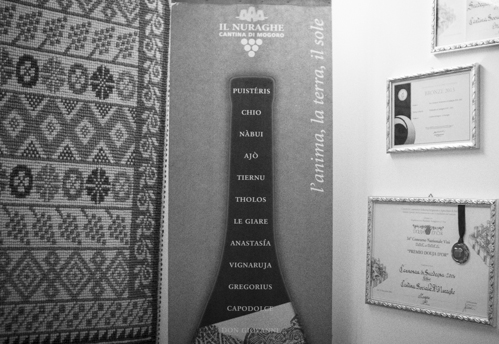Having arrived at Mogoro, we went to the cooperative wine cellar the Nuraghe. Mogoro is a small town of about 4400 inhabitants and it is located in the hilly region of Marmilla. Man has lived in this rich and fertile area for millennia, the most visible trace being the nuraghic complex of Cuccurada consisting of a large complex nuraghe and a settlement. While Cuccurada is residing on a hill, the cooperative, whose named has been taken from the nearby nuraghe, is located in the lowlands of Campidano, easily visible from the highway 131.
The wine cellar was founded in 1956 by a small group of winemakers who were following true and tried agricultural traditions and with the intent of producing artisanal wine of high quality. Today, almost 60 years later, 650 members of the cooperative deliver exquisite grapes to the wine cellar in order to produce wine of the highest quality.
We first entered the wine shop, a welcoming and pleasant space where there were exhibited some of their best wines.
The pride of this company is a dry, white wine called Semidano di Mogoro D.O.C. (Controlled designation of origin), a result of hard work for the last twenty years, a period in which the members of the cooperative did everything possible in order to recover an ancient and excellent grapevine which went almost extinct, turning it into a D.O.C.
The members are also growing other high quality grapevines like: Bovale, Cannonau, Malvasia, Monica, Moscato, Nasco, Nuragus, Sangiovese and Vermentino.
During our visit a member of the staff kindly showed us the whole enterprise, explaining the itinerary of the grapes from arriving at the wine cellar to bottling.
Winemaking is a rather complex process and only a short summary listing the most interesting points will be given below:
When the grapes arrive at the wine cellar, they are let fall down in a big container with a horizonal Archimedean screw which, when being rotated, pushes the grapes into a room where the grapes are separated delicately from the grape stems, a process which is called de-stemming.
From here, different processes are done to make red and white wines.
During crushing of the red grapes, all parts of the grapes are deposited in a container where yeast may be added or the winemaker can decide to use ambient yeast residing on the skin of the grapes. In any case, in the tranquillity of the container a metamorphosis is occurring: the yeast starts the process of fermentation where the sugars in the grapes are turned into alcohol. Exploiting the dissolving action of alcohol and the temperature, usually between 26 and 30°C, the colour pigments and the tannins present in the skin of the grape, are passed to the must. The temperature and the percentage of alcohol are monitored regularly during the fermentation.
The ultimate phase is filtration of the wine in order to remove any remaining solid particles and to make the wine as transparent as possible. Lastly, the wine is bottled and labelled or conserved in oak barrels.
Regarding white wine, the fermentation takes place without contact between marc and must. First, the grapes are crushed, then the must is separated from the solid parts like the skins and the seeds in order to avoid extracting the tannins occurring in the solids. They are crushed again and the resulting must is fermented separately from the must which was obtained first. After fermentation, the wine is bottled and labelled.
This wine cellar is really big compared to the other rather small ones I have visited before and I was pleasantly surprised by the hospitality of the persons showing us around the whole company and the attention the personnel are committing to all the phases of producing their high quality wines.
As a confirmation of the excellence of this wine cellar, they have received numerous prizes for many years.

